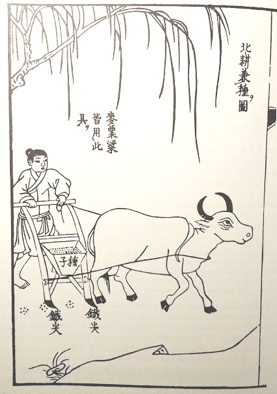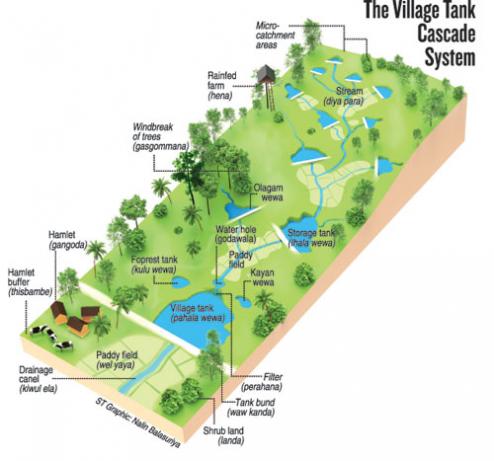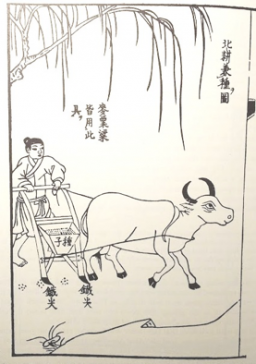Cultivating Water
Water is an essential component of all cropscapes. Crops need water and so too do humans and animals; water slakes the thirst of living creatures, and human populations also use water to keep clean, and for almost every kind of processing and manufacture, from cooking and pot-making to nuclear cooling towers. In fact we can usefully think of water as a crop, carefully planted, tended and harvested by individual farmers, local communities or states.
Techniques for managing water range from setting up a barrel to collect rain from the roof, or matching planting and harvesting to the monsoon, to the building of grandiose irrigation systems like Angkor Wat or Aswan. Here are two typical water-cropping systems, selected among dozens.
Horse-hoeing Husbandry
"Are you able to make low, wet land fruitful? Are you able to conserve dry soils and temper them with damp? Can you purify your soils, making ditches to wash them clean? Can you ensure that your millet heads will be rounded and the husks thin, that the grains will be numerous and plump so that food is plentiful? How may you do all this? By the fundamental principles of tillage." (Annals of Lü Buwei, ca. 239 BCE)
From as early as 300 BCE and through into the modern era, farmers in North China used a specialized repertory of ploughs, harrows, rollers and hoes to capture moisture from winter frosts and scarce summer rains, ridging and draining damp and heavy soils, and creating a crumbly mulch on the surface of dry soils to prevent evaporation. Seeds were planted in rows by drill, maximizing the moisture for each plant and facilitating weeding. Green manures were ploughed in before sowing grain to fertilize and retain moisture in the soil. In eighteenth-century England, apparently independently of any knowledge of Chinese farming techniques, very similar farm implements and principles of tillage were devised by Jethro Tull, author of The Horse-Hoeing Husbandry, and other pioneers of the English Agricultural Revolution. In North China "conserving dry soils and tempering them with damp" was the primary goal, but English farmers were more concerned with "making low, wet land fruitful."

Chinese farmer using seed-drill; 1637 illustration (Tiangong kaiwu)
Tank Irrigation
In monsoon Asia irrigation tanks have been used for over two millennia to capture water from rain or streams so that it can be released in controlled fashion as and when needed. Some tanks were just a few meters across, built by individual farmers. Every spring the farmers dredged and repaired them. A Chinese text of 1149 advises planting mulberry trees around these small tanks: the roots strengthened the banks, the boughs offered precious summer shade to grazing water-buffalo and the leaves were harvested to feed silkworms. The trees also served as buffers, preventing both excessive evaporation and overspills after heavy storms.

Tanks range in size from small to huge. In the dry zone of Northern Sri Lanka networks of huge and small irrigation tanks were constructed under royal order as long ago as 450 CE; today 320 ancient large dams, and 12,000 ancient small dams survive, along with many thousands constructed since. In what is known as the Cascade Tank System, multiple tanks are connected in cascades leading down from the forested hills to the paddy fields below the village. Forest tanks, at the head of the system, not only capture rainwater for the main village tank but also provide water-holes for wild animals, reducing the risk that they will come down to the village and damage crops. Intermediate tanks trap sediments and reduce salinity, and are used to water seasonal crops grown in gardens above the village. The main village tank stores water for human needs and for rice-growing. With civil strife and rural change many of these ancient cascades had become neglected. This affected not only crop yields, but also local drinking supplies, soil erosion, vegetation patterns and biosystems more generally. Partnered by international conservation organizations, the Sri Lankan government has recently embarked on restoration programs for deteriorated cascade systems.

